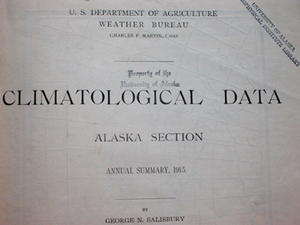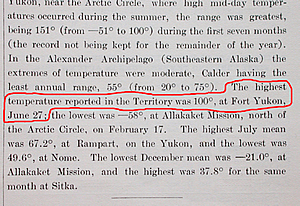Due for a spell of the roaring 90s
Due for a spell of the roaring 90s
Submitted by Ned Rozell
Phone: 907-474-7468
06/25/08


My dad never liked the heat. On humid days in upstate New York, he’d ride out hot spells by sitting in his underwear in front of an electric fan. He got no relief on his only trip to Alaska, when two days of 90-degree June temperatures forced him to hunker down inside my small cabin.
Recent cool temperatures got me to thinking that I hadn’t seen a 90-degree day in a fair chunk of time. But my memory is among the wobbliest of datasets, so I turned to a professional. According to Eric Stevens at the Fairbanks Forecast Office of the National Weather Service, more than a decade has passed since Fairbanks, one of the warmest places in Alaska, reached at least 90 degrees Fahrenheit.
"August, 1994," Stevens said over the phone, remembering the last time Fairbanks reached 90 degrees. "This is the longest stretch of no-nineties in the Alaska climate record, since 1904."
Fairbanks reached 93 degrees on Aug. 5, 1994, and hasn’t reached 90 degrees in the 14 years since.
"It’s global blanding," Stevens joked. "We don’t seem to have many 90s or minus-60s anymore . . . Fairbanks doesn’t get into the 90s very often, but based on the climate record, we’re kind of due."
Due to its location in the middle of Alaska and far from the moderating effects of the ocean, Fairbanks is a good representative of the warmest summer temperatures in Alaska. Stevens did a little more digging and found that, since 1904, Fairbanks has hit 80 degrees or warmer every single summer. And, during the summer of 2004, when an area the size of Vermont burned and much of the state was choked in smoke, Fairbanks had 30 days with highs of 80 or higher, but never reached 90.
"One can speculate that Fairbanks might have hit 90 degrees on a couple of those days if it weren’t for all the smoke cutting down the sunshine," Stevens said.
Anchorage, with an all-time high of 86 degrees Fahrenheit on June 25, 1953, was also warm in 2004, with 14 days hitting 75 degrees or warmer. But Anchorage hasn’t reached 80 degrees since Aug. 16, 2004, when the temperature was 81 degrees. Before that, the city had an 80-degree drought that went back to the summer of ’97. As of late June 2008, Anchorage hadn’t yet hit 70 degrees for the year, the longest such cool spell since 1993.
So, based on historical averages, which really don’t mean much, Alaskans are due for some hot summer days. And Alaska has a hallowed number out there that we haven’t felt in almost a century. In 1915, George Salisbury, a meteorologist with of the U.S. Department of Agriculture’s Weather Bureau in Seattle, wrote a yearly climate summary in which he mentioned Alaska’s pinnacle of heat, which is warmer than the all-time highs of Duluth, Buffalo, and Miami, and is identical to the all-time high temperatures reached in Albany, New York; Cheyenne, Wyoming; Seattle; and the great state of Hawaii:
"The highest temperature recorded in the Territory (in 1915) was 100 degrees, at Fort Yukon, June 27."
This column is provided as a public service by the Geophysical Institute, University of Alaska Fairbanks, in cooperation with the UAF research community. Ned Rozell is a science writer at the institute. This column was first printed in 1999. Rozell is currently out of state.


